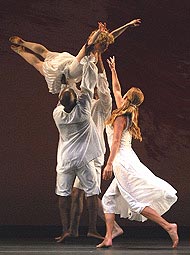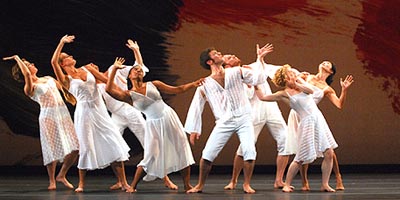Every now and then something occurs to melt the mediocrity of 21st century concerns clean into oblivion. Almost any dance created by Mark Morris can achieve this effect. But even the MacArthur fellow has outdone himself with his latest creation – Mozart Dances, a trio of movement ephiphanies set to two concertos and a sonata, by Mozart. Commissioned to celebrate 250 years of the baroque wunderkind’s brilliance, Mozart Dances premiered last year in New York, bringing critics and mere mortals to their knees with joy and gratitude.
into oblivion. Almost any dance created by Mark Morris can achieve this effect. But even the MacArthur fellow has outdone himself with his latest creation – Mozart Dances, a trio of movement ephiphanies set to two concertos and a sonata, by Mozart. Commissioned to celebrate 250 years of the baroque wunderkind’s brilliance, Mozart Dances premiered last year in New York, bringing critics and mere mortals to their knees with joy and gratitude.
I joined them on Sunday, flying down to Los Angeles just for this chance to see what inspired imagination can do with sixteen brilliantly tuned human bodies, a full orchestra and two grand pianos. The short version of my experience is this: Mozart received the homage he deserves. The long version will take a lifetime – so I’ll provide only a few comments about the experience (which has left me breathless).
A bouquet of three abstract dances – with occasional moments of narrative implication – the groupings seemed to channel the secret heart of this vivacious music. The effect was to hear Mozart for the first time. Or if not for the first time, at least to hear it made new. Legs, arms, fingertips and toes flicking and kicking the notes into the stratosphere with surgical precision, stormy muscularity, breathtaking delicacy and poetic abandon. All of these contradictory moods and attitudes came together and pulled apart, like an intricate crochet of tides surging in and out, and all to the insistent pulse of Mozart’s music.
Morris is a maestro of interweaving the grand and graceful vocabulary of ballet with bits of folkloric whimsy, athletic and even mundane vernacular moves. Set to the lilt of Mozart’s themes and variations, the dancers moved in diagonals, or straight-ahead procession, with disarmingly sudden stances – stopping on a dime – and then re-weaving themselves. Trios emerged and disbanded, repeating movements in fugue, until by the end of any given piece all the 16 sets of arms seemed guided by a single consciousness.
 The two hours were galvanized by exceptional details. As groups of dancers lifted skyward and landed back on their feet, there was no sound. Unearthly. The soarings, rising and falling, like swelling pools and streams of grace, appeared effortless. Playful. Confident. Never ego-laden.
The two hours were galvanized by exceptional details. As groups of dancers lifted skyward and landed back on their feet, there was no sound. Unearthly. The soarings, rising and falling, like swelling pools and streams of grace, appeared effortless. Playful. Confident. Never ego-laden.
The second dance, for which the performers switched from grey to black costumes, comprised an exuberant meditation on circularity. At one point, the men joined hands like children at a playground – then suddenly transformed into Matisse’s dancers. The male dancers shimmered with grace, the women – some of them six-footers – stormed with heroic gestures. Occasionally the men executed the graceful lifts and leaps usually reserved for women in classical ballet. The effect was not so much an overt homosexual subtext as it was a genuine trans-gender study in humanness. Morris erases all genders, and replaces them with the sort of grace that earns the adjective “amazing.”
There were a few Martha Graham moments – the heads snapped upward, the sudden turning of the back, the sprightly diagonal arms and legs in opposition – and occasional Twyla Tharp winks, but on the whole this was Dance made transcendent. Branch lightening crackling and sparkling across the stage. At the end, when the choreographer himself took the stage, the entire hall rose in a single explosive movement and roared its approval through half dozen curtain calls.
Nothing can take the place of being surrounded by the living moment of performance — but for an idea of Morris’ thinking in this work, take a look at this two minute video collage of Mozart Dances. And then watch the Bay Area entertainment calendars for the next time it comes to a theater near you.

